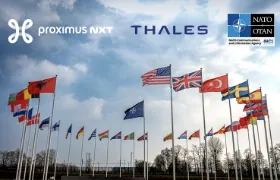RTBF innovates on the Belgian market with live broadcast using Proximus NXT's 5G technology
For the first time, RTBF and Proximus NXT have successfully covered the Viva For Life broadcasts live in Bertrix. To achieve this, several cameras and a big screen were connected to a private 5G network. The success of this pilot project opens up opportunities for other 5G use cases for the RTBF teams in the future.
Last December, for the eleventh Viva For Life week, RTBF organized a major solidarity and fundraising campaign to fight child poverty in the Wallonia-Brussels Federation. From 17 to 23 December, RTBF presenters and teams were deployed in Bertrix, providing round-the-clock coverage on television, radio and social networks as well as online. But that is not all. The 2023 edition also gave RTBF's technical teams the chance to team up with Proximus NXT and test new live coverage technology using a temporary 5G private network.
RTBF and Proximus NXT, supported by its ecosystem of top partners, conducted a "proof of concept" throughout the week of the Viva For Life broadcasts. During this full-scale test, a temporary private 5G network was set up in Bertrix enabling RTBF to connect two remote-controlled cameras and receive video feeds from these cameras in their control room on the event site. These two panoramic cameras were connected to a 5G network dedicated to RTBF, while the audience on site got to watch the live feed on a screen connected to a 5G router.
A full-scale test
The 5G setup for the 2023 Viva For Life edition did not replace RTBF's wired installations, but allowed for testing the use, performance and stability of such an infrastructure during a six-day live event. During these tests, RTBF validated several use cases, hardware and protocols using 5G technology, including remote control, video streaming, mobile (wireless) cameras, remote-controlled cameras, live feed screens, image quality, and latency. After initial tests at A6K in Charleroi, this project was meant to test a private 5G network under real-life conditions and gain more confidence and experience in using this setup for covering major live events.
The success of this full-scale test is excellent news, considering Viva For Life is a mass event with live HD broadcast of audio and video content on various RTBF platforms, requiring perfect image and sound quality and latency-free fluidity. A 5G private network as the one in Bertrix is able to deliver this level of quality, as it is a mobile network dedicated to meet the needs of a particular organization. It offers higher bandwidth guarantees, lower latency and better security than public networks, resulting in guaranteed high performance, greater reliability and enhanced efficiency.
Interesting prospects for the years to come
The success of the Viva For Life test opens up exciting prospects for the future. While RTBF currently relies on wired systems, it has a keen interest in making more use of the mobile network, reducing cable dependence and enhancing camera mobility. Private 5G networks are an ideal solution for media coverage of e.g. sports or cultural events, ensuring network accessibility, performance and stability.
The technical experts of Proximus NXT are eager to continue their collaboration with their colleagues at RTBF in the future to provide viewers and listeners on various RTBF platforms with high-resolution video and audio streams and perfect image quality.
Jean Vanbraekel, RTBF: Viva for Life is a charity campaign organised by RTBF in the Wallonia-Brussels Federation.
It has been taking place for 11 years, always at the end of the year.
The main goal of Viva4Life is to create awareness and collect funds to fight child poverty.
The event consists of a 144-hour marathon during which three presenters take turns providing a continuous radio stream with a 24/7 live broadcast for 6 consecutive days.
In terms of technology, the main challenge we face is to come up with a system that fits into the heart of the city, but that is still as light and as flexible as possible, while always enabling the creation of content across all platforms.
Anne-Sophie Lotgering, Proximus NXT: We've been working with RTBF for many years. And we are working together on what 5G can bring them, on thinking about what could be a use case that responds to their business concerns, how to implement this use case and how it can potentially be used on a larger scale.
This is totally feasible for media businesses as well as for other businesses, whether in public services and healthcare, industry 4.0 or others.
Frédéric Renette, Proximus NXT: We have deployed a private 5G network, specifically for RTBF, so that cameras and screens can be connected to it which will allow them to manage, independently of the public mobile network, the video streams they need to capture images at the Viva4Life event.
The advantages of 5G technology are high bandwidth, low latency and stability.
And because it is a private network, RTBF has total control over the network capacity, so they can transmit all the video streams they need to film such an event on the move.
Jean Vanbraekel: 5G is a technology that allows us to be flexible.
We want to be free from cabling in certain cases.
And we need a guaranteed service, because when we're live, we must be sure that the stream is continuous.
We are very interested in the concept of 'remote production', which means keeping the production tools and controls in our buildings and using 5G to find the content close to our audiences, using our light resources, and simply bringing them back to produce our content.
Anne-Sophie Lotgering: We offer customers end-to-end project management, from the definition of the use case through to the implementation and project management.
Then we also think about how this project could be scaled up. This can lead the customer to think about the infrastructure they need, about their security needs, and storage needs that could be linked to these use cases.
Proximus NXT can provide support to customers in these considerations.


